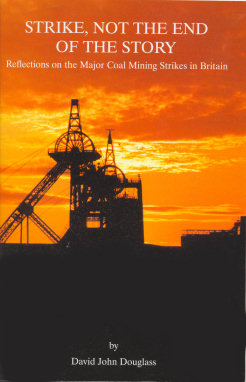
STRIKE, NOT THE END OF
THE STORY
Reflections on the Major Coal Mining Strikes in Britain.
By David John Douglass.
National Coal Mining Museum for
England Publications
4
OVERTON
2005
ISBN 187292509X
FOREWORD (From "Strike, not the end of
the story")
Dave Douglass came to work at the Museum as a researcher on the "Strike,
not the end of the story" exhibition, which was made to mark the
twentieth anniversary of the return to work after the 1984/85 miners'
strike. The exhibition considered mining strikes through history, and
Dave was well placed to comment on those in the latter half of the century.
 |
He was a third generation
pitman, and had been a miner in the Durham and South Yorkshire coalfields
for all his life. He was branch delegate, and later branch secretary,
at Hatfield colliery in the periods before its final closure.
Dave is in the fortunate position of being both a graduate, with am MA in Industrial Relations and Law, and a published author on the history, culture and contemporary industrial relations of the miners and the mining industry. He has been involved with the NUM and the coal industry for the last forty years, and with all the major industrial struggles of the last thirty-six. He was a branch official for twenty-five years, with periods on the Area Executive Committee. Many parts of this book rely on his first-hand accounts and assessments. This viewpoint is his own, and reflects a lifetime at the heart of the industry, at the coal face. Margaret L. Faull
|
Dave takes us back almost three-hundred years to start this journey through
the history of the miners and their struggles against oppression and abuse.
He starts by telling us that in the early 1700s, pit communities everywhere
were regarded as a race apart, and were frequently seen as being wild
and savage, ungodly and rebellious. He paints a picture of a time when
the mine owners were so far removed from the humanity of their workers,
that disputes often led to whole families being turned out onto the street,
taking with them only their meager belongings and the tear stained faces
of their hungry children.
Life was harsh indeed for miners and their families at this time, and
Dave tells us that this led to the brief flicker of a flame that sparked
the first combinations or unions. Many of these colliery associations
were short lived, but by the mid 1800s the Miners Association, with Chartism
as its base, attempted the first ever national coal strike. Later in the
same century, many had organised and joined the MFGB, the Miners' Federation
of Great Britain.
Dave illustrates this part of the journey with excerpts from newspapers
of the time and with an occasional black and white photograph.
He then takes us into the 1900s, a century which saw the whole world
in conflict on two separate occasions, and during which time the miners
continually fought against the oppression and poverty forced upon them
by successive governments.
This era takes up much of Dave's book, and is covered in great detail
with facts and figures relating to coal production and wages. The strikes
of the 1970s, and in particular that of 1984/85, are covered at length,
with ballot count figures, speeches, and the background of the government's
plan to defeat the miners and reduce their union to an impotent force.
Using excerpts from various autobiographies, including those of Thatcher
and MacGregor, Dave tells us what was going on behind the scenes during
those cold and dark autumn months of 1984, when Arthur Scargill and the
NCB were locked in talks, until the single word, "beneficial",
barred any further progress. He also shows just how close the miners were
to claiming a "victory" at that point.
Dave closes the book by taking us into the 21st century and looking at the remains of the ravaged coalfields, and at the poverty and deprivation that has replaced many of Doncaster's once thriving mining communities. In the final few paragraphs Dave shows how the NUM has fallen from its once lofty position of power, to that of offering to take almost any role available in Britain's future energy programmes.
They say you shouldn't judge a book by its cover, but since this particular
book has one of my own photographs on its jacket, I think that old adage
shouldn't apply. This book is every bit as good as it promises to be.
As a piece of historical research it stands alone, and I'm sure it will
become one of the most referenced mining history publications to be used
by future mining historians for years to come.
Adge Covell